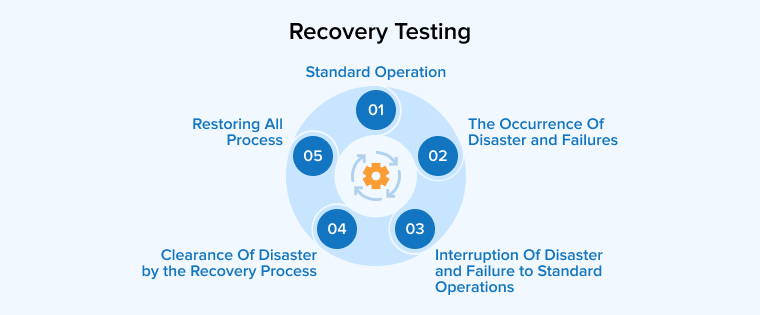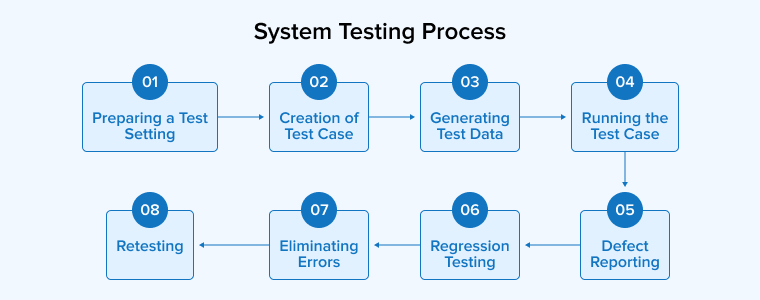
Developers can boost the standard of their software and provide future users with the best possible experience by opting the software testing services. A tester’s ability to pinpoint problem areas in software and deliver useful results to businesses depends on his or her familiarity with system testing. Success in testing is within your reach if you take the time to educate yourself on the issue.
Let’s go through what is system testing, what it checks, the many kinds of system testing, what tools are available, and the advantages and disadvantages of system testing.
1. What is System Testing?

System testing is described as testing an entire, functional version of a software program. This sort of testing is known as black-box testing, and it is performed by the QA team without requiring anybody on the team to be familiar with the code’s internal architecture.
System testing is useful for predicting how users will interact with the program and identifying potential problems. Having a list of specifications is important, but so is comprehending the application. Software testing engineers are the ones who really do this. It is executed in a setting analogous to that of production, letting designers and other concerned parties study how users react.
2. What is the Purpose of System Testing?
Here’s brief answer from Quora on what is the purpose of system testing:

Now let’s understand this in detail!
- System Testing is the phase in which a whole software testing cycle is completed, which is essential. This is performed after the integration testing and prior to acceptance testing.
- During system testing, one can simulate real-world conditions so that stakeholders may get a true feel for how users will interact with the system in the future.
- It lessens the need for follow-up troubleshooting and support inquiries after a deployment.
- The application infrastructure and operational objectives are evaluated at this phase of the STLC.
- If you want to give the customer a top-notch product, you need to put a lot of effort into system testing.
- The functional and business requirements and application structure are investigated during this testing. It is not necessary for a software tester to have prior knowledge of programming in order to carry out the steps of the System testing methodology.
- Post-production issues can be mitigated with proper execution of this testing. It will test the entire component’s hardware or software, enabling you to swiftly uncover any faults or bugs that eluded integration testing and unit testing.
- Throughout testing, you’ll encounter conditions that mimic those seen in real life or the workplace. The system testing includes end-to-end system evaluation.
To better grasp the user’s viewpoint and head off issues when the system goes public, beta testing is done in a setting that is equivalent to the production one. Several test scripts are used to ensure the system’s overall efficiency and to ensure that the system meets the technological and economic requirements of its users.
3. Scope of System Testing
We have learned about system testing so far in this article. Let’s have a peek at how far it goes.
- System testing methodology, when put into practice, outlines a process for verifying the operation of a complete, integrated system in order to detect and eliminate bugs.
- Finding issues, insufficiencies, or unfulfilled needs before deployment helps cut down on post-deployment troubleshooting and support calls.
- The system specification may be checked off as met with the use of testing to ensure compliance.
System testing involves running tests on the industry best practices and the application architecture to prevent any issues from occurring and to correct them in advance. This testing is essential since it guarantees the end user a functional and reliable product.
4. Objectives of System Testing
System testing aims to reduce potential problems with how a system operates in a given setting. To do this, they replicate the conditions in which the final product will be deployed.
Each aim is a smaller, more manageable step toward the larger goal. System testing verifies various checkpoints that must be met before a fully functional system (or bug-free piece of software) is released to the public.
The major objectives of system testing are as follows:
4.1 Lessening Potential Dangers
When it comes to making sure your software is ready for prime time, system testing is a must. Reducing potential dangers and ensuring a more efficient rollout for your users may be accomplished by detecting and fixing these problems in advance of release.
4.2 Eliminating Glitches
Testing a system as a whole to see if it performs as expected and adheres to the criteria laid forth in the functional specifications is known as system testing. The goal of any system test is to reveal any bugs, functionality issues, or absent prerequisites in the system under scrutiny.
4.3 Verifying Design
The goals and needs of the system must be met before testing begins. In other terms, it is used to ensure that the system was built to the correct requirements.
4.4 Validating the System
Testing a system ensures that it functions as intended and is free of bugs.
5. Types of System Testing

System testing is a collection of all software testing types since it encompasses all the primary testing types. Products, processes, deadlines, and needs all have a role in determining which types of testing are prioritized.
Here are some types of system testing that play an essential role in the software testing process.
5.1 Functionality Testing

To ensure that the product’s performance meets the required criteria while remaining within the constraints of the system, this phase evaluates whether the system, and notably its functionalities, abide by the objectives.
Throughout functional testing, analysts might think of ways to improve a product by listing down prospective add-ons. The data supplied reflects both human and automated testing settings.
5.2 Recovery Testing

By simulating various input mistakes and other failures, you can evaluate the method’s resilience to failure. You can also determine if it can recover from system shutdowns, hardware malfunctions, and other major difficulties.
As more modules are added to the queue over time, it also prevents previously fixed issues from reappearing. It is a test of the system’s ability to withstand disturbances from outside sources.
5.3 Performance Testing

In order to ensure your system is operating as intended, you need to do performance testing to ensure all of its parts are meeting the required standards. It determines whether or not the system meets its performance requirements, like throughput or response time.
5.4 Usability Testing

The goal of usability testing is to ensure that the system is easy to understand and use by simulating actual user interactions with the product. Test subjects will be given a set of tasks to complete using the system. It is recommended that you fine-tune the application’s performance and address any difficulties that may arise as it is being used.
5.5 Load Testing

It is a type of non functional testing. Seeing how a software solution performs under realistic conditions is crucial.
In load testing, the efficacy of an application is evaluated by applying loaded user traffic that is either below or equivalent to the expected load. Here, traffic or load refers to N-number of concurrent users accessing the application or submitting requests to the server.
Load testing will assist in identifying an application’s utmost operating capacity and any constraints. It regulates how the software application functions when used simultaneously by multiple users. Load testing is primarily used to evaluate the efficacy of Client/Server and web applications.
Read More – How to do Distributed Load Testing using Apache JMeter?
5.6 Migration Testing

Migration testing makes sure that the software can be altered easily on the new hardware if it is required. This test is conducted to guarantee that the program will run properly on both the old and new systems without any problems.
5.7 Regression Testing

Regression Testing is essential to the system’s resilience, since it unifies the many subsystems and maintenance tasks , and guarantees that new system alterations do not damage current functionality. The current state of the system is compared to how it operated in a prior version of the test.
5.8 Hardware/Software Testing
System tests is a comprehensive method for evaluating a system’s functionality, including its hardware and software components. HW/SW testing is IBM’s term for testing both hardware and software. Here, it focuses only on the system’s functionality and not its underlying structure.
Each bit of gear is put through its paces to make sure it does what it’s supposed to. It may be essential to check the system’s cabling, power source, and input/output elements, as well as the performance of each piece of software that forms up the system under evaluation.
There are other types of system testing that include system integration testing, acceptance testing, stress testing, security testing, compatibility testing, scalability testing, reliability testing, installation testing, recovery testing, smoke testing, sanity testing, exploratory testing, end testing.
6. System Testing Process

When it comes to testing software, there are a few different tiers to choose from. Because of this, you need to prepare well by doing the following:
6.1 Preparing a Test Setting
Create a document describing the fundamental goals of a testing procedure. It is essential to produce a detailed guideline for testers to better comprehend the scope of a project. Give details about the types of testing you intend to carry out along with methods for integrating them in accordance with the company’s protocol. Then, you examine the hardware devices and other tools a tester might require to complete the stages of each system test.
6.2 Creation of Test Case
What comes next is thinking about the test case. In this testing process, here we create test cases.This document covers the specifics of what needs to be tested and how that testing will be carried out. Included in the paper should be details on what is required to pass or fail every test.
6.3 Generating Test Data
The generation of test data follows the development of a test case. This information is crafted with the test case’s inputs and outputs in consideration. Both good and negative conclusions can be drawn from this information. Much consideration must be given while developing test data to ensure that all necessary fields are included and nothing is overlooked.
6.4 Running the Test Case
The next step is to design a system test plan for executing the test case and obtaining the resulting data. The success or failure of the test case will be displayed in the output.
6.5 Defect Reporting
This error or flaw should be simulated in the test case to demonstrate the system’s response. Planning for system testing requires knowledge of problem reporting and resolution processes.
6.6 Regression Testing
The purpose of regression testing is to ensure that the addition of new features has not resulted in the introduction of any problems or the disruption of any previously working functionalities. There are technologies available to make this procedure more efficient.
6.7 Eliminating Errors
It’s also crucial to have a strategy for fixing problems. While it’s true that not all bugs can be eradicated, it’s crucial to have a system in place to determine which ones can and which ones can’t be solved.
6.8 Retesting
When a system test is completed and a defect is noted, the project team should strive to resolve the issue, and then the test would be run again to ensure that the issue has been resolved as intended. You should do system tests to ensure that no bugs remain hidden in your code. If more testing is required, either all subjects or a subset of them will need to be retested.
7. Tools Used for System Testing
The preceding is a collection of complementary tools for use in system testing.
7.1 Robot

There are many software testing tools and libraries already available for use with the Robot framework, but you are free to create your own as well. There is no integration between the software and the operating system. Whilst Java and .NET both have interfaces in the core libraries, Python is utilized to execute the framework’s underlying mechanisms.
7.2 Gallen

The Gallen framework allows System testing to be automated. As the framework is open-source, integrating it into the workflow is a breeze.
7.3 Selenium

Selenium is a free and open-source framework for automating browser and platform-independent testing of online applications. By automating common test cases in the Selenium framework, testers may cut down on test times. When integrated into a CI/CD workflow, this test automation framework may help guarantee a reliable, error-free rollout to production.
Read More- What is Selenium Testing?
7.4 JMeter

When it comes to checking how well a website or web app performs, one of the tools you may use is JMeter. To test a server’s resilience or analyze its general effectiveness under different sorts of stress, it can mimic a high requirement on a network or other entity.
7.5 LambdaTest

LambdaTest is a digital testing service that facilitates System testing via its robust and safe Selenium Grid environment. Higher test exposure and substantially quicker build times are the results of using LambdaTest to automate cross-browser testing between 3000+ browsers and operating systems.
Your web app’s cross-browser and cross-OS compatibility may be evaluated. Testing locally hosted web pages is now possible with LambdaTest Tunnel. It is possible to run a single test in concurrently across multiple browsers and operating system versions.
8. Advantages of System Testing
Check this quick piece of answer from Quora on why is system testing is important in order to carry it out well:

- This testing does not need advanced programming skills on the part of the testers.
- It will put the whole product or program through its paces, allowing you to see any flaws or faults that were missed throughout the earlier unit and integration testing.
- The testing environment mimics what a company would experience in real life.
- A variety of test scripts are used to ensure that the system as a whole meets both the technological and commercial needs of the customer.
- After completing this round of testing, the development team will be secure in moving on to acceptance testing, which will address the remaining potential defects or mistakes in the product.
- Finds issues with the entire system early on in the design phase.
- Assists in verifying the objectives and making sure the system can handle the user’s demands.
- Boosts the consistency and high-quality of the system.
- Aids in the sharing of information and coordination of efforts between the testing and development teams.
- Betters the system’s efficiency overall.
- Boosts trust and decreases danger for users.
- Helps find problems quickly so they may be fixed.
- Helps in finding relationships between modules and system-level dependencies.
- Adds to the system’s versatility and ease of upkeep.
9. Disadvantages of System Testing
- This kind of testing takes more time than others since it does a comprehensive scan of the products or application in concern.
- It necessitates having the necessary tools and infrastructure on hand. Complete software testing comes at a huge markup.
- If a decent debugger isn’t used, any underlying problems will remain undetected. Especially for big and sophisticated systems, this may be a difficult and time-consuming process.
- Depending on how well the objectives and design documentation are written.
- There is not much we can see of the system’s inner workings.
- Depends on things like hardware and network settings that are outside of your control.
- It needs preparation, cooperation, and execution on all fronts.
- It’s possible for it to be affected by revisions made in development.
- Necessitates the use of certain knowledge and abilities.
- It’s possible that a number of test cycles may be needed before the desired results are reached.
10. Conclusion
System testing, sometimes called system-level testing, is the process of verifying that all of an application’s parts work together as intended. It involves analyzing the system as a whole to meet certain functional or design criteria.
As we’ve seen, there are many moving parts to System testing, and this article has helped us understand their significance.
With it, you may pinpoint problems and requirements that aren’t being met by the program as a whole. This ensures that the system fits up to the standards set by its users. If you want to use the system in a way that deviates from the norm, you’ll need a Software Requirements Specification (SRS) or System Requirement Specification.
If your organization has the facilities to carry out both functional and non-functional System testing in-house, you can employ people who have thorough familiarity with the entire process. Note that the development team does not undertake System testing; rather, a dedicated team tests the entire system independently. Its purpose is to provide an objective evaluation of the system’s performance.






I am not a technical person and I do not have any knowledge about testing, but I found this article to be very informative for me. It made me aware of system testing and the factors to consider when planning and executing system tests.